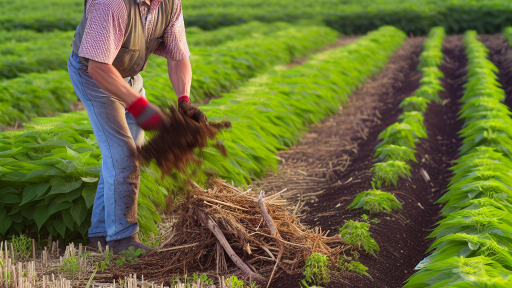Introduction to Crop Rotation and Its Importance for Soil Health
Crop rotation involves alternating the types of crops grown in a specific area.
This practice significantly enhances soil health and fertility.
Different crops have varying nutrient requirements and contribute uniquely to the soil.
By rotating crops, farmers can maintain and improve soil structure.
Benefits of Crop Rotation
One of the main benefits of crop rotation is the reduction of pests and diseases.
Certain crops attract pests that can harm other plants.
Rotating crops disrupts the cycles of these pests, leading to healthier plants.
Additionally, diverse planting reduces the risk of crop failure due to disease.
Enhancing Soil Fertility
Crop rotation also enhances soil fertility naturally.
Legumes, for instance, fix nitrogen in the soil.
This process increases available nutrients for the following crop.
As a result, crops grown after legumes tend to perform better.
Soil Structure and Erosion Control
Another advantage of crop rotation is improved soil structure.
Diverse root systems from various crops help bind soil together.
This binding effect reduces soil erosion caused by wind and water.
Transform Your Agribusiness
Unlock your farm's potential with expert advice tailored to your needs. Get actionable steps that drive real results.
Get StartedUltimately, maintaining soil structure supports agricultural sustainability.
Implications of Crop Rotation Practices
Crop rotation is essential for promoting healthy soils.
The numerous benefits it provides lead to sustainable farming practices.
Incorporating this approach ensures long-term agricultural success.
Understanding Soil Nutrient Dynamics in Crop Rotation
The Basics of Soil Nutrients
Soyl nutrients are essential for plant growth and development.
They include macronutrients like nitrogen, phosphorus, and potassium.
Additionally, micronutrients such as iron and zinc play vital roles.
Each nutrient supports different plant functions.
For example, nitrogen aids in leaf development, while phosphorus enhances root growth.
The Role of Crop Rotation
Crop rotation significantly influences soil nutrient dynamics.
This practice involves alternating different crops in the same field.
It helps prevent nutrient depletion and soil degradation.
By rotating crops, farmers can utilize the different nutrient needs of each plant.
As a result, this method contributes to improved soil health.
Benefits of Crop Rotation
Implementing crop rotation provides numerous benefits.
- It reduces pest and disease buildup in the soil.
- Different crops often have varying root structures.
- This diversity helps maintain soil structure and health.
- Rotating legumes can enhance nitrogen levels in the soil.
Nutrient Cycling and Soil Health
Nutrient cycling is a crucial aspect of healthy soils.
Rotating crops facilitates the natural process of nutrient replenishment.
For instance, deep-rooted plants can access nutrients unavailable to shallow-rooted ones.
This synergy improves overall soil fertility over time.
Best Practices for Effective Rotation
To maximize soil health, follow these best practices.
- Plan rotations based on nutrient needs of each crop.
- Incorporate cover crops during off-seasons.
- Avoid planting the same crop in consecutive seasons.
By adopting these strategies, farmers can build resilient soils.
Healthy soils lead to improved crop yields and quality.
Common Crop Rotation Strategies: An Overview
Importance of Crop Rotation
Crop rotation plays a crucial role in sustainable agriculture.
It enhances soil fertility by varying plant types grown in succession.
Showcase Your Farming Business
Publish your professional farming services profile on our blog for a one-time fee of $200 and reach a dedicated audience of farmers and agribusiness owners.
Publish Your ProfileThis practice reduces pest and weed pressures effectively.
Additionally, it helps in managing soil erosion and nutrient depletion.
Basic Principles of Crop Rotation
The foundation of effective crop rotation lies in diversification.
Diverse crops promote healthier soil ecosystems.
Moreover, rotating crops disrupts pest and disease life cycles.
Consequently, this leads to reduced reliance on chemical inputs.
Common Crop Rotation Strategies
- Legume-Cereal Rotation
- Root Crop-Cereal Rotation
- Cover Crop Inclusion
- Multispecies Crop Mixing
Legume-Cereal Rotation
This strategy alternates legumes with cereal crops.
Legumes enrich the soil with nitrogen through their root nodules.
Cereals benefit from improved soil nutrient levels.
As a result, overall crop yields increase.
Root Crop-Cereal Rotation
Root crops, such as potatoes and carrots, are rotated with cereals.
This method helps in breaking soil compaction.
Root crops improve soil structure and aeration.
Subsequently, cereal crops grow more vigorously.
Cover Crop Inclusion
Integrating cover crops in rotation is an effective strategy.
Cover crops prevent soil erosion during off-seasons.
They also suppress weeds and enhance soil organic matter.
Furthermore, cover crops promote soil moisture retention.
Multispecies Crop Mixing
Growing different species together can enhance crop resilience.
This method fosters symbiotic relationships among plants.
Moreover, it leads to diversified pest management strategies.
Thus, farmers can achieve a higher degree of ecological balance.
Gain More Insights: Organic Solutions for Hydroponic Cultivation
Benefits of Crop Rotation on Soil Structure and Fertility
Improved Soil Structure
Crop rotation enhances soil structure significantly.
Different root systems create varied soil channels.
These channels improve water infiltration and drainage.
As a result, crops experience less waterlogging.
This reduces compaction in the soil.
Enhanced Nutrient Availability
Certain crops replenish essential nutrients in the soil.
For instance, legumes fix nitrogen, enriching the soil.
This makes nitrogen available for subsequent crops.
Additionally, diverse crops take up different nutrients.
Consequently, nutrient depletion is minimized over time.
Reduction of Pests and Diseases
Crops often attract specific pests and diseases.
By rotating crops, farmers disrupt pest life cycles.
This leads to a natural decrease in pest populations.
Moreover, diverse crops reduce the spread of diseases.
Healthier plants result from this strategic rotation.
Increased Soil Organic Matter
Crop rotation encourages the accumulation of organic matter.
Plant residues from various crops enrich the soil.
Showcase Your Farming Business
Publish your professional farming services profile on our blog for a one-time fee of $200 and reach a dedicated audience of farmers and agribusiness owners.
Publish Your ProfileOrganic matter improves soil fertility and structure.
Furthermore, it enhances microbial activity in the soil.
Thus, healthier soil supports better crop yields.
Improved Soil Moisture Retention
Diverse root systems improve moisture retention capabilities.
This maximizes water use efficiency for crops.
Healthy soils retain moisture better during dry spells.
As a result, farmers require less irrigation.
Ultimately, this promotes sustainable agricultural practices.
You Might Also Like: Enhancing Soil Health with Strategic Mulching
Pest and Disease Management Through Effective Crop Rotation
The Importance of Crop Rotation
Crop rotation reduces pest and disease cycles in the soil.
By alternating crops, farmers can disrupt the life cycles of harmful organisms.
This natural strategy enhances soil health significantly.
Understanding Pest and Disease Dynamics
Pests and diseases often thrive on specific host plants.
Rotating crops introduces new species that pests cannot easily adapt to.
This switch minimizes the chances of infestations.
Identifying Compatible Crop Sequences
Selecting a diverse range of crops is essential.
Legumes restore nitrogen, while grains can suppress weeds.
Additionally, cruciferous plants help control certain pests.
Implementing Seasonal Plans
Seasonal planning keeps pest populations in check.
This approach allows farmers to rotate between summer and winter crops.
Moreover, planned succession helps maintain soil fertility.
Monitoring and Evaluation
Consistent monitoring of crop health is vital.
Farmers should evaluate pest populations and disease occurrences regularly.
This information aids in refining crop rotation strategies.
Integrating Additional Practices
Combining crop rotation with cover cropping enhances pest management.
Cover crops can suppress weeds and promote biodiversity.
Implementing these techniques further boosts soil health and resilience.
Gain More Insights: Sustainable Practices for Post-Harvest Processing

Selecting the Right Crops for Your Rotation Plan
Understanding Crop Compatibility
Selecting compatible crops is vital for effective rotation.
Certain crops can enhance soil fertility, while others may deplete it.
For example, legumes introduce nitrogen back into the soil.
Conversely, root crops can improve soil structure and aeration.
Consider the nutritional needs of the soil when planning your rotation.
Assessing Soil Health
Healthy soil supports productive crop growth.
Test your soil regularly to determine nutrient levels.
Utilize soil amendments as needed to maintain balance.
Organic matter plays a crucial role in soil health.
Incorporate cover crops to enhance soil fertility and moisture retention.
Utilizing the Benefits of Diversity
Diverse crop rotations can break pest and disease cycles.
This practice reduces the need for chemical interventions.
Showcase Your Farming Business
Publish your professional farming services profile on our blog for a one-time fee of $200 and reach a dedicated audience of farmers and agribusiness owners.
Publish Your ProfileAdditionally, it improves the resilience of crops to environmental stresses.
Include a mix of grains, legumes, and vegetables in your rotation.
Such diversity nourishes beneficial soil microorganisms.
Considering Local Climate and Conditions
Each region presents unique growing conditions.
Understand your local climate and soil types before planning.
Choose crops that thrive in your specific area.
Acknowledge microclimates on your land that may require tailored choices.
Consult local agricultural extensions for crop recommendations.
Planning for Economic Viability
Include economic factors when selecting crops.
Market demand should influence your rotation decisions.
Assess the cost of inputs versus potential profits for each crop.
Rotate high-value crops with lower-risk options to stabilize income.
This strategy can help mitigate financial risks.
Uncover the Details: Using Technology to Enhance Post-Harvest Management
Timing and Frequency: Best Practices for Implementing Crop Rotation
Understanding Crop Rotation
Crop rotation significantly improves soil health over time.
This practice breaks pest and disease cycles effectively.
It promotes nutrient balance in the soil as well.
Choosing the Right Cycle
Selecting an appropriate crop rotation cycle is crucial.
Your choice should consider local climate and soil conditions.
A common rotation cycle includes legumes, grains, and root crops.
This variation enhances nutrient diversity in the soil.
Implementing Seasonal Changes
Timing is critical when implementing crop rotations.
Spring planting typically requires earlier soil preparation.
Autumn crops need consideration for frost and harvest schedules.
Regularly assess soil health throughout the growing season.
Frequency of Rotation
The frequency of crop rotation can impact yield significantly.
A three to four-year rotation cycle can be effective.
Avoid growing the same crop in consecutive seasons.
Frequent changes help maintain soil fertility and health.
Monitoring Soil Conditions
Regular soil testing is invaluable in crop rotation practices.
It helps determine nutrient levels and pH balance.
Maintain an understanding of organic matter content as well.
Incorporating Cover Crops
Including cover crops in your rotation can enhance benefits.
They protect the soil during off-seasons.
Cover crops also prevent erosion and improve soil structure.
Additionally, they can fix nitrogen in the soil.
Educating Farmers on Best Practices
Farmers must stay informed about crop rotation strategies.
Participating in local workshops and training is beneficial.
Farmers can share experiences and learn from each other.
Evaluating and Adjusting Practices
Finally, continuously evaluate the effectiveness of your crop rotation.
Showcase Your Farming Business
Publish your professional farming services profile on our blog for a one-time fee of $200 and reach a dedicated audience of farmers and agribusiness owners.
Publish Your ProfileAdjust practices based on crop performance and soil health.
Flexibility is key to long-term agricultural success.
Case Studies: Successful Crop Rotation Examples in Various Climates
Temperate Climate Success: The Smith Family Farm
The Smith family implemented a three-year crop rotation system.
They grew corn, soybeans, and alfalfa in this rotation.
This approach improved soil structure and fertility significantly.
Moreover, it reduced pests and diseases among their crops.
As a result, their yields increased by 30% over five years.
Tropical Climate Innovation: GreenField Co.
GreenField Co. operates in a humid tropical region.
They rotate cassava, maize, and legumes systematically.
This strategy enhances nitrogen fixation in the soil.
Consequently, it helps sustain crop productivity year after year.
They reported a remarkable reduction in soil erosion.
Arid Climate Adaptation: Desert Oasis Farms
Desert Oasis Farms thrives in an arid environment.
Their rotation includes drought-resistant crops like millet and sorghum.
This practice minimizes water usage effectively.
Furthermore, it improves soil moisture retention for future crops.
Recent yields doubled due to these innovative techniques.
Cold Climate Strategy: Northland Growers
Northland Growers faces a short growing season.
They successfully rotate barley, oats, and clover.
This mix helps capture nutrients and prevents soil depletion.
The clover acts as a green manure, enriching the soil.
Farmers noted a 20% increase in soil organic matter.
Lessons Learned from Diverse Regions
Crop rotation strategies vary significantly across climates.
Adapting these practices to local conditions yields great benefits.
Farmers must consider soil types, climate, and crop selection.
Successful rotations improve soil health and crop resilience.
Ultimately, these practices lead to sustainable agriculture.
Additional Resources
Soil Health Principles and Practices | Farmers.gov
Long-Term Evidence Shows that Crop-Rotation Diversification …




